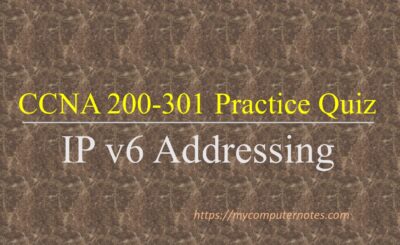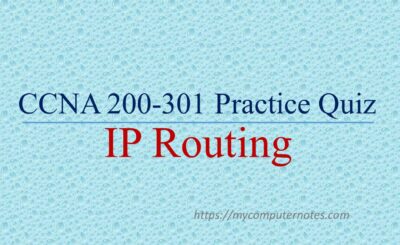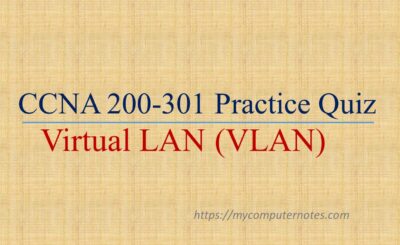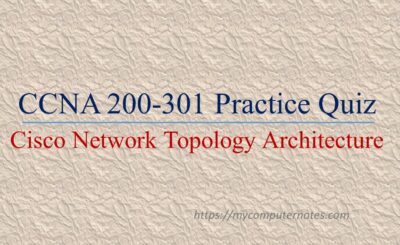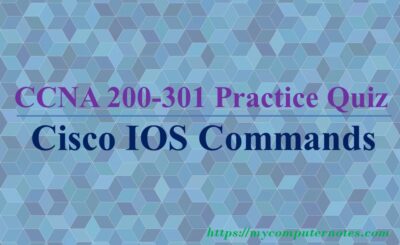
This quiz section contains a CCNA practice quiz on OSPF v2. You can test your skills on the functionalities of OSPF v2. The following quiz section contains multiple-choice questions, drag and drops as well as “refer to the exhibit” questions as per the CCNA 200-301 Exam pattern.
The CCNA practice quiz is very helpful for the preparation for CCNA 200-301 certification exam.
Each question is provided with the correct answer and an explanation for the correct answer. Click on the button named “Answer” just below the question to view the answer and the explanation. You can hide the answer and the explanation by re-clicking the “Answer” button.
CCNA Practice Quiz – OSPF v2
|
1. The acronym for OSPF is _______.
Answer: Option A Explanation: The correct option is A.
|
|
2. Which of the following algorithm is used by OSPF to determine the best path from source to destination?
Answer: Option C Explanation: The correct option is C.
Dijkstra’s algorithm was introduced by Dutch Scientist Edsger W. Dijkstra in 1956. It is used to find the shortest path between the two nodes.
|
|
3. Which of the following parameters are compulsory to configure OSPF v2 on an active router interface? Choose any two.
Answer: Options C and D Explanation: The correct options are C and D.
OSPF Process id and the OSPF area are the mandatory parameters while configuring OSPF on a router interface.
For example, when configuring OSPF with area 0 and the process id 1 with the network number 192.168.1.0/24, the following sequence of commands needs to be run.
Router(config)#router ospf 1
Router(config-router)#network 192.168.1.0 0.0.0.255 area 0
|
|
4. Which of the following statements are not true regarding the configuration of OSPF routing protocols? Choose any two.
Answer: Options D and E. Explanation: The correct answers are D and E.
For a single area OSPF network, we can use any area number ranging from 0 to 4294967295.
The area number and the OSPF process-id must not be the same while configuring OSPF.
|
|
5. Which of the following statements describe the characteristics of OSPF routing protocols? Choose any three.
Answer: Options A, B and D. Explanation: The correct options are A, B and D.
The OSPF is configured with a single autonomous system (AS).
The administrative distance of OSPF is 110.
|
6.Refer to the exhibit. Which of the following address is used by the router R1 as its OSPF router-ID?
Answer: Option D Explanation: The correct option is D.
Loopback address is used as OSPF router-ID. The loopback address is 192.168.10.10.
|
7. What are the benefits of using hierarchical design for a larger OSPF network?
Answer: Options A, B and E. Explanation: The correct answers are options A, B and E.
The hierarchical design of the OSPF network helps to segregate a larger network into a smaller network. Each separate can be grouped into a separate area. The smaller area helps to reduce routing overhead, reduces convergence time and confines network instability to a single area.
|
|
8. What is the value of the administrative distance of OSPF?
Answer: Option C Explanation: The correct answer is option C.
|
|
9. A network administrator configures OSPF routing in a router with the following command. However, when he adds the new router to the OSPF network, other OSPF router doesn’t show the newly added network in their routing table. What is wrong with the command below?
Answer: Option C Explanation: The correct answer is option C.
The wild card mask is configured incorrectly. The wild card mask is the inverse of the subnet mask. OSPF configuration used a wildcard mask instead of a subnet mask.
|
|
10.Which of the following are the correct way of configuring OSPF in a router and add network number 10.10.10.0/24 to area 0? Choose any two.
Answer: Options B amd E Explanation: The correct answers are B and E.
The correct command to configure the OSPF to add network number 10.10.10.0/24 to area 0 is as-
Router(config)#router OSPF
Router(config-router)network 10.10.10.0 0.0.0.255 area 0
|
|
11. Which version of OSPF is used by the IPv6 address?
Answer: Option B Explanation: The correct answer is option B.
|
|
12. Which of the following multicast address is used by the OSPF Hello protocol?
Answer: Option A Explanation: The correct option is A.
|
|
13. What do you call an OSPF router that connects the internal OSPF router with the network outside OSPF autonomous system?
Answer: Option C Explanation: The correct option is C. The autonomous system boundary router or ASBR connects the internal OSPF router with the router outside the OSPF AS. |
14. Which of the following does not belong to a type of OSPF packet?
Answer: Option C Explanation: The correct option is C.
The link-state response is not a valid OSPF Packet. There are five different types of OSPF packets namely Hello packet, Data description, link-state request, link-state update, and link-state acknowledgement.
|
|
15. The two adjacent OSPF routers exchange Hello packet between them to establish a neighbour adjacency. Which of the two values in the Hello packet must match with both the routers in order to establish a neighbour adjacency.
Answer: Options B and D Explanation: The correct options are B and D.
|
|
16. What are the default OSPF hello and dead timers on an Ethernet connection?
Answer: Option B Explanation: The correct option is B.
|
|
17. Which of the followings OSPF command is used to determine that two adjacent OSPF routers have exchanged information in order to build a neighbour relationship?
Answer: Option A Explanation: The correct answer is A.
|
|
18.What is the default router priority value for all OSPF router?
Answer: Option B Explanation: The correct option is B.
The router priority value ranges from 0 to 255. The default priority value for all cisco routers is 1. The priority value is needed while selecting DR and BDR.
|
|
19. When DR and BDR election is needed in the OSPF network?
Answer: Option C Explanation: The correct option is C.
|
|
20. A network administrator has to configure a single-area OSPF router with network number 192.168.10.0/30. What would be the wildcard mask that jas to be stated on the OSPF network command?
Answer: Option C Explanation: The correct option is C.
The network id 192.168.10.0 has network bits 24. Hence the subnet mask will be 255.255.255.252. The wild card mask is the inverse of the subnet mask. The wild card mask will be 0.0.0.3.
|
| ← Prev | Next → |


